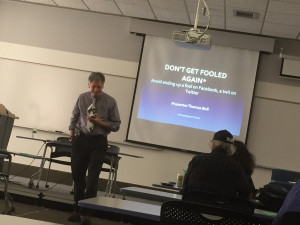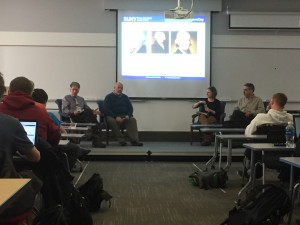Don’t Get Fooled – Fake News Day

Professor Thomas Boll of Syracuse University’s Newhouse school of Public Communications and Onondaga Community College hosts Fake News Day at SUNY Poly on March 16, 2017.
“Truth will ultimately prevail where there is pains taken to bring it to light.”
It was in an August 1794 letter that George Washington wrote those words and more than 200 years later, pains are still taken to bring to light the truth. However, as the many ways in which information is disbursed grew since Washington’s time, so did the ways in which to misinform.
The term “fake news” has become a popular phrase since the 2016 election, but the question of what actually is fake, what is truth have made it all the more difficult to determine what is happening in the world around us.
It’s with that in mind that SUNY Poly held a Fake News Day on March 16, with two opportunities to hear from experts on news, information, and the way it makes its way into people’s hands and minds.
Featuring Professor Thomas Boll of Syracuse University’s Newhouse School of Public Communications and Onondaga Community College, the day began with with an interactive workshop helping attendees to detect false reports before they believe or share them.
“The insidious stories today is what I have a problem with as they’re put together like fake stories, but packaged as if they’re real,” Boll explained to the crowd.
Part of the ease in packaging any message to appear official is technology such as social media. Illustrating this, Boll told the tale of a Senator from a southern state whose staff was posting articles to Facebook, but using Facebook’s ability to customize headlines to change the headlines into a phrasing that was critical of the senator’s opponents.

Professor Thomas Boll of Syracuse University, WUTR/WFXV News Director Tom Coyne, Associate Professor of History Dr. Kristina Boylan, and Professor of Political Science and Information Design & Technology Dr. Steve Schneider discuss misinformation and the media during Fake News Day at SUNY Poly on March, 16, 2017.
Later in the day, Boll was joined by a panel whose experiences in their respective fields helped to bring insight into the long-existing, but rapidly growing dissemination of falsehoods. The panel featured Boll, as well as WUTR/WFXV News Director Tom Coyne, SUNY Poly Associate Professor of History Dr. Kristina Boylan and SUNY Poly Professor of Political Science and Information Design & Technology Dr. Steve Schneider.
How can it be fixed? What can be done?
The panel faced some heavy and not necessarily easy to answer questions.
Boll suggested they start by standing by journalists that show reason to believe in them.
“Support the journalists who are doing good work,” he said. “Tell the ones that they’re doing good. Because they are under attack.”
“Actually changing someone’s mind is a very difficult thing to do,” Dr. Boylan said. “The key is emotional persuasive storytelling.”
While false information has been around for a very long time, Coyne pointed out that its escalation in recent time comes through the growing methods of distribution. He sites the desire for web clicks as one of the other driving forces for such a proliferation of misinformation. The more web clicks, the more revenue, giving an example in recent years of a lawmaker’s aide named Cameron Harris who spent but a few dollars on a domain name called christiantimesnewspaper.com and filled it with stories he made up. In just a short period of time, driven by web clicks of those who wanted those stories to be true, as they aligned with their own beliefs and views, Harris’ site and domain went from a value of a few dollars to tens of thousands of dollars. Not a bad return on investment. However, since exposure, the site has since been shut down. Harris isn’t the only, however, to try and make it work.
“If you look at what the people who organized a lot of the sites during the 2016 campaign, a lot of the sites originated out of a block in the old Soviet Union,” Coyne said. “They didn’t give a rat’s behind who got elected. They wanted clicks. When they found where the most clicks were coming from, they did more of that.”
Surely those providing those clicks checked to see if what they were reading was accurate, right? Not necessarily. All the panelists seemed to be in agreement that in today’s fast-paced world of instant gratification, most people aren’t verifying what they read, especially if it aligns with their own preconceived beliefs or viewpoints.
“One thing I think this whole fake news thing has shown us is that we’re not necessarily willing to look at both sides of an issue,” Coyne said. “The con artists are counting that we won’t do any research. In the pre-internet days, you got your news from newspapers, television, or radio. And, for the most part, that news came from people who were trained in research, the proper cultivation of sources and the legal framework of what they had to say. There was a filtration system that was reliable.”
The technology exists, as does a craving for clicks by the fabricators, and a desire by those clicking to reaffirm what they already believe – so what can be done?
Dr. Schneider says that whatever concerns there may be, he worries the remedies may be worse than the disease. He believes the remedy for fake news is the marketplace, explaining that our society has always relied on the private marketplace, but with some regulation.
“It’s really up to us as consumers to come up with strategies to find out what’s there,” Schneider explained. “The concept of fake news is not really about spreading falsehood, but about creating doubt of what is true. That uncertainty…that certain things are true or aren’t true causes unrest in society. When there’s chaos and unrest, that’s when fascism has an opening to take over.”
Recent Comments
Archives
- September 2018
- August 2018
- May 2018
- April 2018
- March 2018
- February 2018
- January 2018
- December 2017
- November 2017
- October 2017
- September 2017
- May 2017
- April 2017
- March 2017
- February 2017
- January 2017
- December 2016
- November 2016
- October 2016
- September 2016
- August 2016
- May 2016
- April 2016
- March 2016
- February 2016
- January 2016
- December 2015
- November 2015
- October 2015
- September 2015
- August 2015
- May 2015
- April 2015
- March 2015
- February 2015
- January 2015
- December 2014
- November 2014
- October 2014
- September 2014
- August 2014
- May 2014
- April 2014
- March 2014
- February 2014
- January 2014
- December 2013
- November 2013
- October 2013
- September 2013
- August 2013
- June 2013
- May 2013
- April 2013
- March 2013
- February 2013
- January 2013
- December 2012
- November 2012
